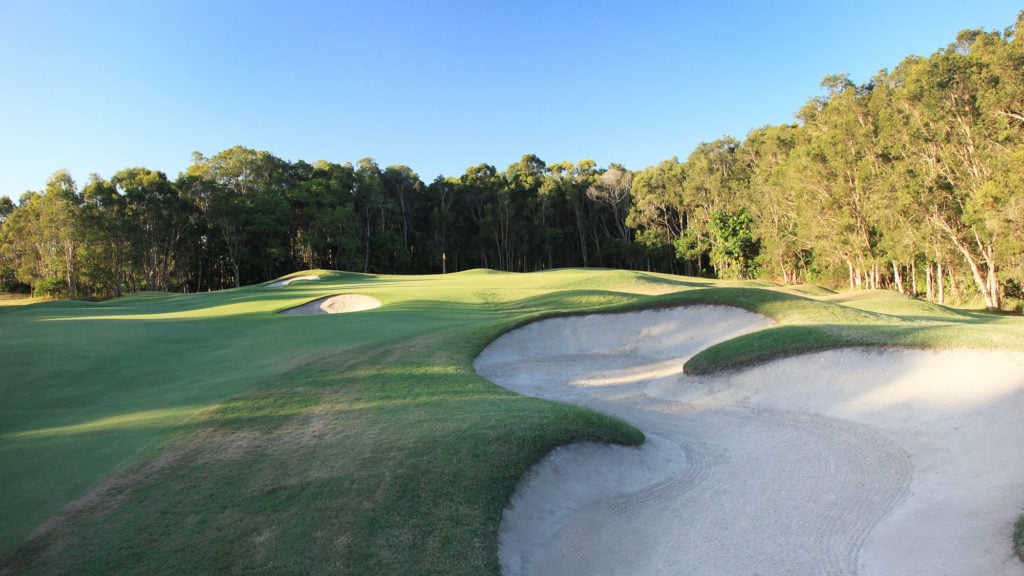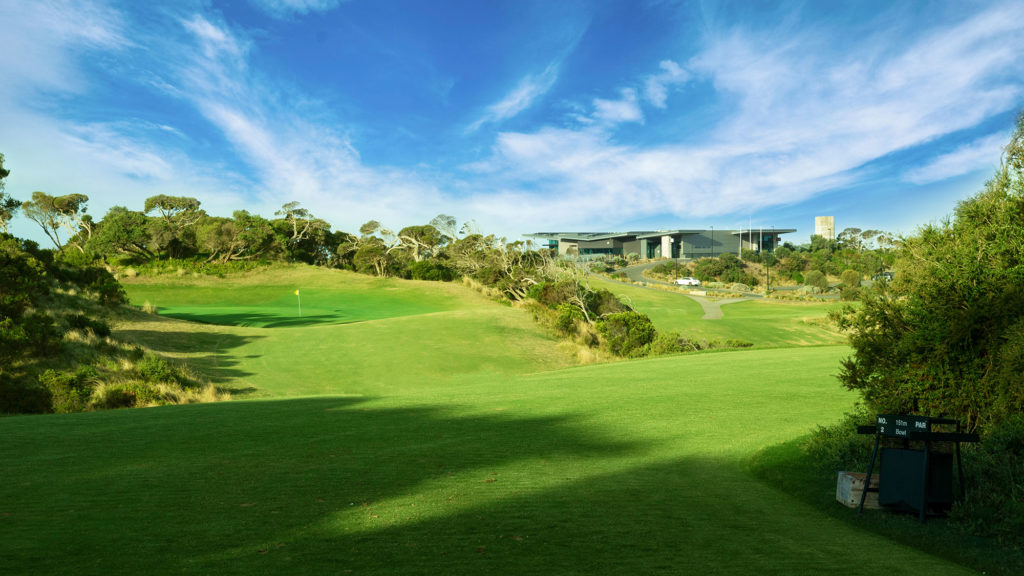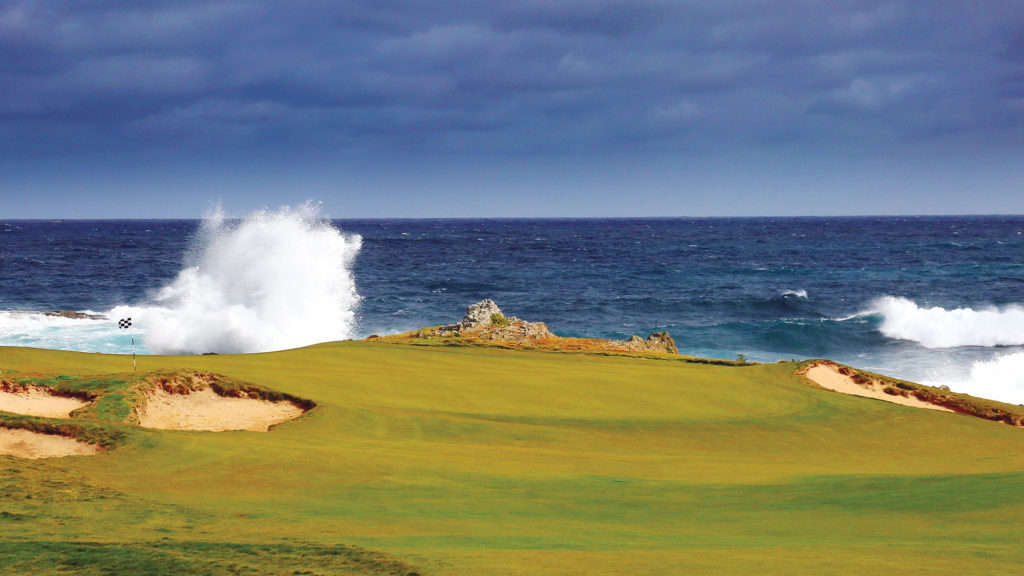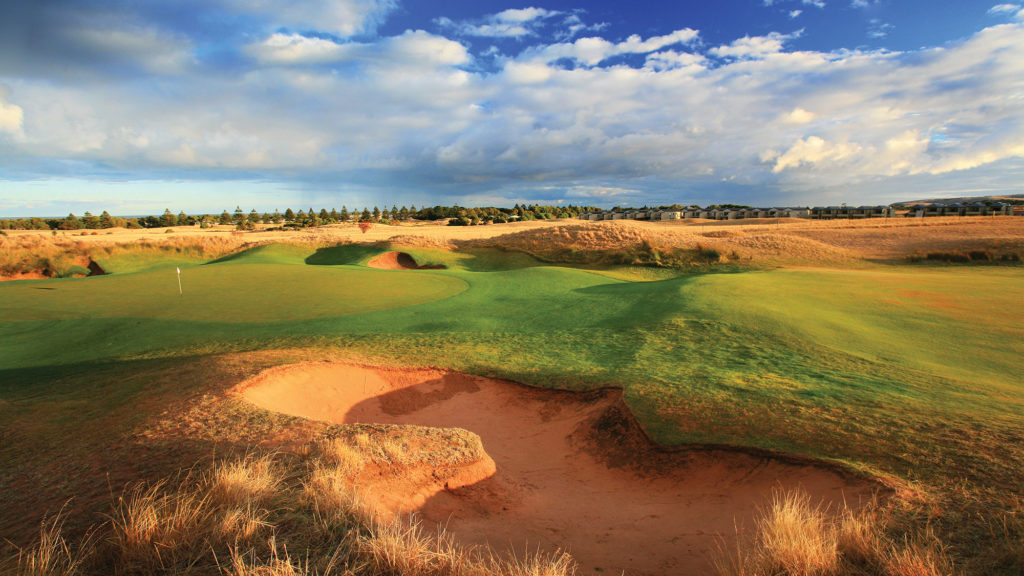The true definition of links golf remains confoundingly fuzzy, but in Australia and New Zealand we still know links-style golf when we see it.
The eighth hole at Twin Waters Golf Club in Queensland is said to be an homage to the famous Road Hole on the Old Course at St Andrews, where the centuries-old par 4 will again harass and confuse the field at the 150th Open Championship this month.

Peter Thomson, in his popular design collaboration with Mike Wolveridge on the Sunshine Coast, used similar design traits without penning a straight-out replica hole. Like the 17th at the Old Course, the eighth at Twin Waters doglegs sharply right, but around a lake and a sprawling fairway bunker rather than alongside railway sheds, a hotel and a stout stone wall. And it features a green set at an oblique angle that’s best approached from the more dangerous right-hand side. There’s even a menacing pot bunker defending the putting surface, although not one bearing likeness to the famous one in eastern Scotland.
It speaks volumes for the variety inherent in the arenas of our sport that a links-style golf course can exist a mere 26 degrees away from the equator and on a marshy site in a place where daily maximum temperatures historically surpass 20 degrees Celsius throughout winter. That you don’t have to travel to Scotland or even Europe to experience links golf – and can play links-style golf courses in sultry Queensland, no less – is a triumph of modern design and its enduring versatility.
“There’s not one hole with a bunker in front – you can run it up onto every green,” says Steve Hutchison, Twin Waters’ long-time general manager, of the layout’s links-like qualities. “The rippled fairways, humps, bumps and pot bunkers do give the place that linksy feel.”

It’s a similar story down the road at Links Hope Island, another Thomson-led exercise in bringing British-style golf to the Sunshine State. On this occasion working in concert with Wolveridge and Ross Perrett, the five-time Open champion beautifully melded pot bunkers and rumpled features with the lakes and other water features of the flat site. At Hope Island, for 16 holes you battle against genius design, savvy contouring and Thomson’s signature pots while trying to build a score. Then you arrive at the 17th tee, either with a promising scorecard in hand or after being completely flummoxed by the intricacies of the layout. Either way, you’re greeted with arguably the toughest hole on the Gold Coast. Whether you attempt the 17th from the 230-metre back tee or the more sedate 188-metre whites, what confronts golfers is an all-water-carry par 3 with sand also in play around the perched green. It’s a hole that demands perfection and repels anything less than that. The more meek (and perhaps the more cerebral) will instead play safely to the right, pitch on and accept the higher likelihood of a bogey but lower quotient for disaster.
Further north, there’s more of the same to be found at Palmer Sea Reef at Port Douglas, where the tropical climate and vegetation makes links golf seem utterly incongruous, yet the trio of Thomson, Wolveridge and Perrett pulled it off with aplomb. Imparting links designs into a thoroughly non-links setting illustrates how ground features rule in this style of golf, and how the winds whistling off the Irish or North seas and frigid temperatures are not prerequisites.
“Links courses are the purest style of golf and are bound to be copied,” Perrett says. “The best definition of linksland relates to the underlying geology e.g. wind-blown sands featuring wispy roughs, a free-draining base and closed contours, and general contours of plus or minus a metre.”
Perrett notes the differences between the classic and manufactured links courses, especially in Queensland where the sites are anything but land reclaimed from the sea – the archetypal definition of a links.
“With projects like Hope Island, heavy clay soils and poor drainage were the norm. However, the Japanese client was insistent on a links course – and he got one. Our response was to incorporate grassy hollows and swales, elevated greens and pot-style bunkers, albeit in a resort style. At Twin Waters, we were blessed with a sand base and a suitable landscape. The Links at Port Douglas (Palmer Sea Reef’s original name when it opened in 2000) was an interesting project set in a tropical landscape on a sandy base. The site was an old canefield with a tropical rainforest dividing the site into two halves.”

Natural environment
As trendy and innovative as it may be for links courses to be built in Queensland, there’s something satisfying about seeing them in their normal habitat. One of the best to emerge in recent times is Lonsdale Links on Victoria’s Bellarine Peninsula. The revitalised Lonsdale Golf Club has become a must-play course simply for the fresh and unique approach taken to the redesign process.
Led by Ashley Mead from Ogilvy Cocking Mead, the firm brought to Australia the concept of ‘template holes’, as nine of the new-look 18 feature time-honoured design traits borrowed from elsewhere. Much like one musician might pay tribute to another through a cover track, OCM gave Aussie golfers their own versions of a Biarritz green, a Redan, a punchbowl green, a thumbprint green, the Alps and even a Road Hole. All in all, it’s a wonderfully modern take on links golf with a collection of old-school design tools that make for a tremendous experience.
“It wasn’t like a lot of those ideas were really preconceived before we started,” Mead says of the course that re-opened for play in December 2020. “The more time we spent on the site, looking at different areas… we realised there were parts of Lonsdale that reminded us of The National Golf Links [of America].”
As such, the work of Charles Blair Macdonald, the legendary architect of the famed course on New York’s Long Island, drove much of the impetus for OCM’s template holes. These renditions are definitely a highlight, however there’s more than a sprinkling of uniqueness across the site. For those who recall the prior version of the layout at Lonsdale, not everything was altered in the redesign. The routing of the holes hugging the saltmarshes on the edge of Lake Victoria remain as a key part of the front nine, although the bunkering and green complexes received a refresh. There was initially talk of using that portion of the property for more holes, however it proved too environmentally sensitive so the club instead purchased some adjoining farmland along a different boundary and utilised that space. This meant that holes 11, 14, 15 and 16 are brand new, while most of the last 12 holes were reworked from a position perspective. The result is a short but intricate links that tests throughout and gave the Lonsdale site new life.
Across Port Phillip Bay at Portsea Golf Club lies one of the most quintessential links-style courses in the country. Portsea’s meandering layout, undulating land and natural bunkers – many of which are simply sandy pits weathered by time – combine for a coastal links experience to remember. Offering numerous opportunities to attack with a bold shot on short par 5s and driveable par 4s, Portsea is likely to be more an exercise in restraint for most golfers. The temptation is there to bully the 5,747-metre course into submission, but chances are the player will come off second best unless the daring shots can be struck with equal quantities of accuracy and precision along with power.
Portsea, which is soon to embark upon a bunker refurbishment program as well as the restoration of a disused par 3 that will act as a spare hole, is an icon of Mornington Peninsula golf. The brawnier, more modern iterations of links golf elsewhere on the peninsula have captured golfers’ attentions since the turn of the millennium, but the timeless appeal of its old-school design has kept Portsea at the forefront when it comes to links golf in Australia.

The seaside location and cool climate of northern Tasmania makes for one of the world’s most potent breeding grounds for modern links golf. Now with three courses, the Barnbougle Dunes complex has proven for nearly two decades that golfers will travel to remote locations if the links experience is worth it. Much younger but equally impressive are Cape Wickham Links and Ocean Dunes on King Island, where the central Bass Strait setting can and does serve up a range of fierce conditions but the golf courses match that intensity with smart design features to help golfers work with the weather.

Anything for a lady
The clue is right there in the name. Links Lady Bay sits a few hundred metres from the sea on the coastline south of Adelaide, but is links-like in more ways than can be counted. The design collaboration between Jack Newton, Graeme Grant and John Spencer emerged in 2000 during a time when there was a strong influx of new courses, most in more populated areas. As such, Links Lady Bay didn’t quite receive the fanfare it deserved, yet more than two decades on its refined qualities continue to entice.
The course occupies a sloping plain overlooking the Gulf St Vincent, but a huge spur in the land provides a secluded pocket that is home to a few holes on the back nine. Throughout are rugged, craggy bunkers and bouncy fairways that give the layout its links essence. Yet Grant recalls a design that evolved and didn’t necessarily begin as a links-style layout.

“It was accidental,” Grant remembers. “It was a sheep farm. In all our correspondence with the owner, Mike Hill, I was talking more about a course like Kingston Heath or a course like one of the Sandbelt courses – that’s the way I saw the land in the beginning. But sand had to be transported around the property from certain sections of the property, and when we took it out of some areas, it actually turned it into something like linksland. And it evolved that way, so we ended up with something that does in some ways resemble links golf.”
Lady Bay was a residential project in conjunction with the golf course but one where the golf component was allowed to shine. The two nines were built 18 months apart, which gave the designers the opportunity to adapt and alter their plans without constraints. “Mike Hill was prepared to sacrifice land for housing if it was in the best interests of the golf course,” Grant says. “He was brilliant to work with.”
The result is a genuine slice of links golf an accessible distance and a pleasant drive away from Adelaide in a region known for wine, beaches and other attractions. Having a top-class golf course as well merely adds to the overall appeal.

Long white links
Australia might be home to a more diverse set of links-style courses, but New Zealand can lay claim to the more fervent links activity in recent times. The 2015 opening of Tara Iti – and its instant acclaim that sent it to No.1 in the country – showed the capabilities of the region north of Auckland. That two more courses at neighbouring Te Arai are in the pipeline only heightens the appetite.
There’s a problem, though. Tara Iti is intensely private, and even if you can score a tee-time, it’s expensive and non-members are only permitted to visit the golf course once. While the two Te Arai courses will be far more accessible, neither is open yet. Which means you need to get your Kiwi links fix elsewhere.
Fortunately, there’s a terrific option in the region that is an ideal winter haven. A 45-minute drive west of the city and set flush against the Tasman Sea is Muriwai Golf Links, which is highly regarded in Auckland golf circles for its dryness underfoot in winter and overall playability during the cooler, wetter months. The site’s volcanic black sand is free-draining, which lets any moisture seep below the surface and gives golf balls life as they bumble along the ground.
With fairways resembling rumpled blankets and its coastal location, Muriwai is a genuine links layout that asks for control and shot-making prowess – plus a little luck – in order to score well. The fairway contours don’t always offer predictability and the shapes around the greens demand precision. The bunkering is not overdone but most of the pots are greenside, which further enhances the need for strong approach play.
All of the above traits neglect to mention one ever-present factor: the wind. If the ground game doesn’t challenge you, the aerial conditions surely will. Winds whipping off the Tasman give the course multiple personalities and can turn docile holes into beasts. The innocent-looking eighth hole, for instance, measures no longer than 153 metres yet can require any club from a three-quarter wedge to a full-blooded driver. Muriwai is links golf at its volatile and fascinating best.
The rest of New Zealand is scattered with an array of fine links and links-style courses. Paraparaumu Beach Golf Club, where Steve Williams first discovered golf and where Tiger Woods contested the 2002 New Zealand Open won by Craig Parry, is a links gem. It sits about as far from Wellington as Muriwai is from Auckland and is equally susceptible to the influence of the Tasman Sea but also Cook Strait. On a peninsula near the capital is Miramar Links, a course that exhibits links qualities throughout. On the South Island, Chisholm Links in Dunedin claims to be the southernmost links course in the world and is a former PGA Tour of Australasia venue.
Golfers could make a strong case for a renaming of New Zealand to: the Land of the Long White Links.
